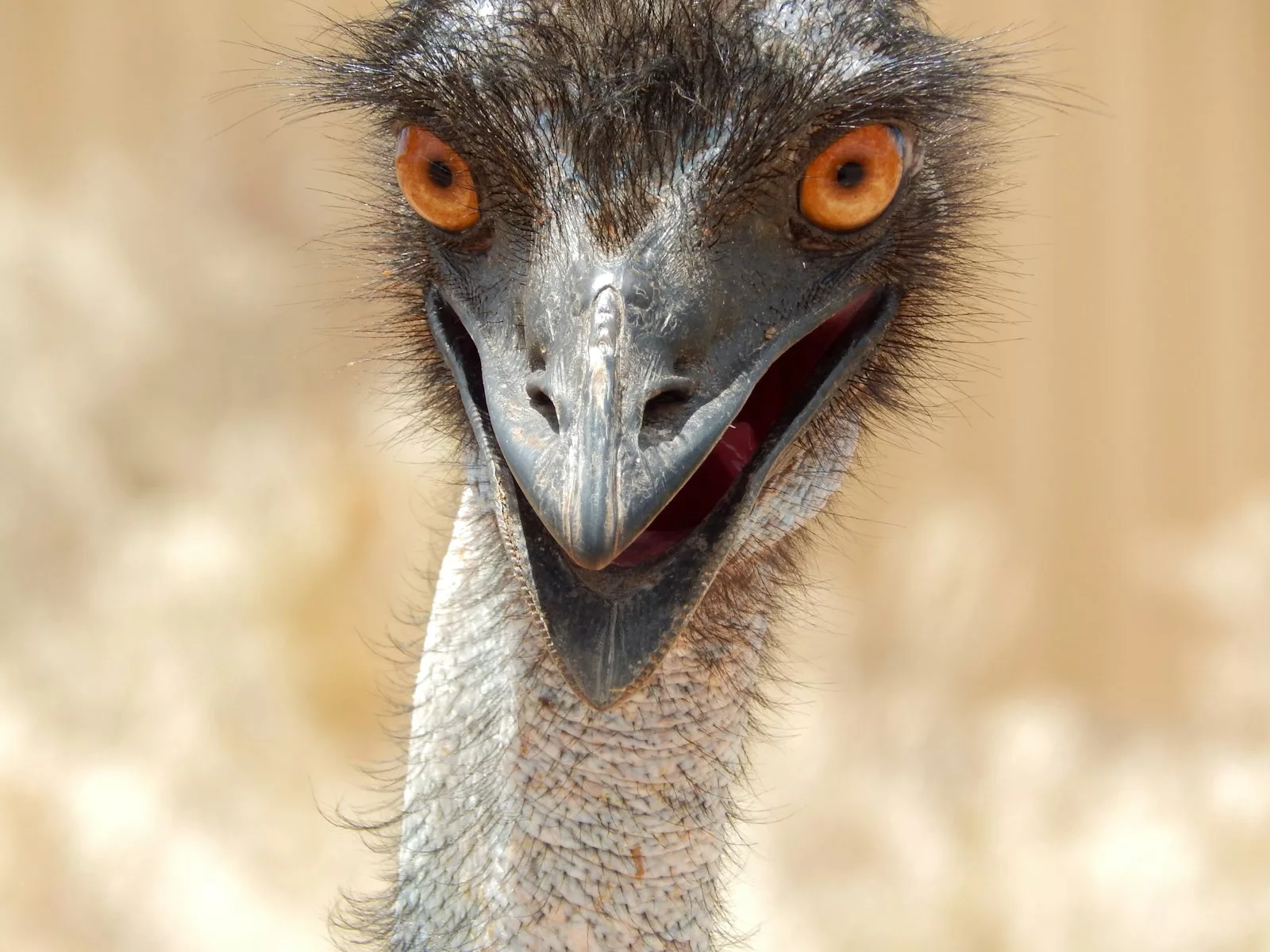History is filled with wars fought between nations, but one of the most bizarre and unexpected conflicts ever recorded was waged between humans and birds. The Great Emu War of 1932 remains one of the most peculiar, bewildering, and somewhat humorous episodes in Australian history. It was a time when the Australian government, in response to an overwhelming emu population wreaking havoc on vital farmland, took an unprecedented step: it deployed armed soldiers to engage in battle against the large, flightless birds. The result? A complete failure on the part of the humans, and an astounding victory for the emus.
Despite their lack of formal military training, the emus proved to be elusive, resilient, and surprisingly strategic in their movements, outmaneuvering the human forces at almost every turn. Soldiers armed with Lewis machine guns and 10,000 rounds of ammunition were deployed with the intent of swiftly eradicating the avian menace. However, instead of a decisive battle, what followed was a prolonged campaign of frustration, inefficiency, and eventual retreat. As reports of the failed military operation emerged, the situation quickly transformed into a national embarrassment, sparking both public amusement and controversy over the government’s handling of the crisis.
The Great Emu War was not merely an isolated instance of human-wildlife conflict; it was a dramatic illustration of the power of nature and the limits of human control over the environment. This article delves into the underlying causes of the conflict, the key battles waged between man and bird, and the lasting legacy of this astonishing yet absurd confrontation in Australian history.
The Background: Why Did the War Begin?
The Struggles of Australian Farmers
In the early 20th century, Australia was facing severe economic difficulties following World War I and the Great Depression. The agricultural sector, in particular, was struggling as prices for wheat and other crops plummeted. Many returning Australian soldiers were offered land in Western Australia to farm as part of a government settlement scheme. The idea was to provide them with livelihoods and simultaneously boost agricultural production. However, this well-intentioned plan soon ran into unforeseen problems. The land offered was often arid, difficult to cultivate, and lacked sufficient infrastructure to support large-scale farming.
To make matters worse, financial assistance for these soldier-settlers was limited, and many of them lacked prior farming experience. The harsh conditions and declining wheat prices left them in a precarious situation, making any additional threats to their crops all the more devastating.
The Invasion of the Emus
Emus, large flightless birds native to Australia, became an unexpected and overwhelming adversary of the farmers. Each year, as thousands of emus migrated from the inland regions toward the farmlands in search of food and water, they discovered the wheat crops of Western Australia to be a perfect feeding ground. The sheer number of emus—estimated to be in the tens of thousands—posed a major problem.
In addition to consuming vast quantities of crops, their massive numbers trampled fences, making it easier for other pests such as rabbits to invade farmland. The fences, originally designed to keep out smaller pests, were simply no match for the strength and persistence of the emus, who often pushed them over or found ways around them.
The farmers, overwhelmed by the destruction and facing financial ruin, appealed to the government for help. Given that many of these farmers were former soldiers, they suggested a military-style intervention. The government, eager to appease the struggling farmers and protect food production, agreed. What followed was an almost surreal military engagement between humans and birds, one that would soon become a notorious chapter in Australian history.
The War Begins: The Emus vs. The Soldiers
Deploying the Military
In November 1932, the Australian government sent Major G.P.W. Meredith of the Royal Australian Artillery to lead the campaign. He was accompanied by two soldiers, two Lewis machine guns, and 10,000 rounds of ammunition. Their mission was to eliminate the emu population that was devastating the farmlands. The operation was expected to be swift and effective, with the military confident in their ability to control the situation with superior firepower. However, the emus proved to be much more challenging adversaries than anticipated, demonstrating remarkable agility, speed, and resilience against human tactics.
The First Engagement
The first battle occurred on November 2, 1932, near Campion, Western Australia. Around 50 emus were spotted, and the soldiers carefully positioned themselves for an effective assault. The machine guns were set up, and the soldiers waited for the ideal moment to open fire. However, as soon as they started shooting, chaos ensued. The emus, rather than fleeing in a single mass, instinctively split into small, dispersed groups, making it incredibly difficult to take them down in large numbers. Their erratic movements and incredible speed allowed them to escape relatively unscathed, with only a handful of birds falling victim to the first barrage of gunfire.
Undeterred, the soldiers attempted to reposition themselves for a second round of attacks, hoping to cut off the emus’ escape routes. However, the birds displayed an uncanny ability to anticipate human movements, often zigzagging in unpredictable directions and frustrating the soldiers’ aim. The thick plumage of the emus also played a role in their resilience, as some birds appeared to withstand multiple shots before eventually collapsing.
To complicate matters further, the terrain itself became a formidable obstacle. The rugged Australian outback, filled with uneven ground and dense vegetation, made maneuvering heavy weaponry and vehicles particularly difficult. Machine guns mounted on trucks were intended to provide a mobile advantage, but the bumpy landscape rendered them nearly useless, with gunners unable to maintain a steady aim. The soldiers soon realized that despite their advanced weaponry, they were not prepared for the sheer unpredictability of their feathered foes.
The initial attempt at an easy eradication campaign had now turned into an embarrassing struggle, forcing Major Meredith and his men to rethink their strategy. Rather than a decisive and swift victory, the military found itself locked in a battle of endurance against a relentless and highly adaptive opponent. The Great Emu War had begun, but it was already clear that it would not end as quickly or successfully as planned.
Learning from Their Mistakes
Determined to refine their strategy, the soldiers tried ambushing large groups of emus near water sources. They carefully selected locations where the birds were known to gather, hoping to take them by surprise. However, the emus quickly adapted and began avoiding these areas when they sensed human presence, showcasing an impressive ability to learn from previous encounters. The soldiers attempted to conceal themselves and remain motionless for extended periods, but the emus’ heightened awareness and unpredictable movements made ambushes largely ineffective.
In another attempt, the military mounted one of the machine guns on a truck, believing they could chase down the emus and shoot them more effectively. This new tactic seemed promising at first, as it provided the soldiers with mobility and increased firepower. However, the rough terrain of the Australian outback made it impossible to aim accurately while moving. The trucks frequently hit bumps and potholes, causing the machine gunners to miss their targets. To make matters worse, the birds simply outran the truck, demonstrating their incredible speed and endurance.
The soldiers also experimented with herding the emus into enclosed areas where they could be more easily targeted. However, the emus proved to be too fast and unpredictable, often escaping before the soldiers could close in. Some reports even suggest that the birds’ natural flocking behavior allowed them to coordinate movements in ways that frustrated human efforts. The attempt to mechanize their assault and develop more strategic plans ultimately proved to be more of a hindrance than a solution, as the emus continued to outmaneuver their armed opponents. The failure of these revised tactics only added to the growing embarrassment of the campaign, leading military officials to question whether their approach was viable at all.
The Emu Victory: How the Birds Triumphed
### Tactical Intelligence of the Emus
One of the reasons the military failed was the remarkable agility and resilience of the emus. Observers noted that the birds appeared to use guerrilla warfare tactics, moving in small groups rather than staying in large clusters. This behavior made them harder to target effectively. Unlike conventional prey that would scatter randomly, emus exhibited a surprising level of coordination, as if working in tandem to evade their human pursuers. Reports from soldiers indicated that emus would take turns watching for threats, seemingly warning one another of approaching danger. This adaptability and innate survival instinct made them formidable adversaries.
Additionally, emus have strong legs and a high running speed (up to 50 km/h or 30 mph), which allowed them to escape gunfire quickly. They would often change direction suddenly, frustrating the soldiers attempting to track and shoot them. Some emus displayed an astonishing ability to absorb injuries and continue running, leading some soldiers to nickname them “bulletproof birds.” In one particularly baffling instance, an emu reportedly survived multiple gunshots and continued sprinting away as if unscathed. These factors combined to create an opponent far more elusive than the military had anticipated.
Poor Weapon Effectiveness
Despite firing thousands of rounds, the soldiers only managed to kill about a few hundred emus, far from their goal of wiping out the birds. Machine guns, designed for use against human combatants, proved inefficient against fast-moving animals with thick feathers that sometimes even deflected bullets. The emus’ natural armor, consisting of densely packed feathers and strong muscles, seemed to make them unusually resistant to injury. Observers noted that even when an emu was hit, it would often continue running for long distances before collapsing, if at all.
Additionally, the emus’ unpredictable movement patterns made accurate shooting nearly impossible. Soldiers found that their automatic weapons, which were effective against stationary human targets, were nearly useless against these agile creatures. The frustration among the troops grew as they realized that their technological advantage was being nullified by sheer biology and adaptability. Some accounts suggest that the gunners resorted to chasing after individual birds in desperation, only to be outrun repeatedly.
The Government Retreats
After multiple failed attempts and growing public ridicule, the Australian government decided to withdraw the military effort on December 10, 1932. The campaign was deemed an embarrassment, and no further military actions were taken against the emus. Journalists covering the conflict had begun to mock the government’s inability to control a flock of birds, with headlines painting the situation as a comical failure rather than a serious endeavor.
Farmers, left to fend for themselves, eventually resorted to fencing and other agricultural measures to control the birds. Some officials suggested alternative population control measures, such as encouraging hunting or relocation, but none proved as dramatic as the failed military operation. In later years, bounty systems were introduced, incentivizing civilians to cull emus instead of relying on the military. Improved fencing strategies and better agricultural planning ultimately provided more effective, long-term solutions to the emu problem than machine guns ever could.
Aftermath and Legacy
The Lasting Impact on Farmers
Although the Great Emu War was a failure, the problem of crop destruction by emus did not disappear. In later years, the government introduced a bounty system, where civilians could hunt emus in exchange for monetary rewards. Additionally, the introduction of better fencing techniques proved to be more effective than military intervention. The experience also led to increased investment in researching ecological methods for managing wildlife without resorting to extreme measures.
A Tale of Absurdity and Humor
The Great Emu War has since become an infamous episode in military and ecological history. It is often cited as an example of the unpredictable consequences of human intervention in nature. While the event was serious for the farmers who lost their crops, it has taken on a humorous reputation over time. The idea that an organized military force armed with machine guns could fail so spectacularly against birds is often met with amusement. Today, it serves as a reminder that nature can sometimes outsmart even the most advanced human technologies.
Conclusion
The Great Emu War of 1932 remains one of the most bizarre and amusing conflicts in recorded history. It highlights the unexpected consequences of human-animal interactions and serves as a cautionary tale about underestimating the resilience of nature. Despite having machine guns and military tactics, the Australian government was unable to defeat an army of determined birds. In the end, the emus won, securing their place in history as the undefeated champions of an unusual war. The legacy of the Great Emu War endures as both a historical curiosity and a lesson in the folly of trying to control nature with brute force.




